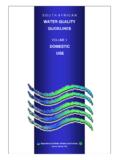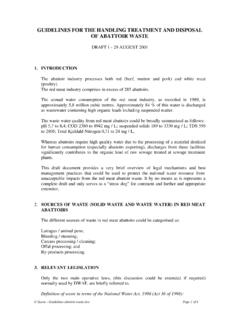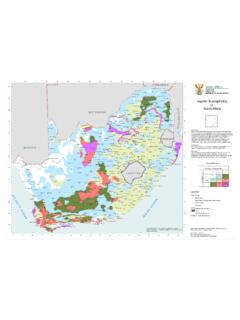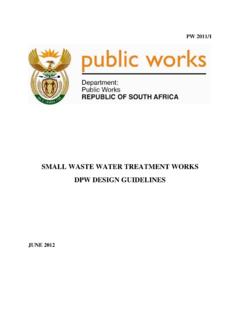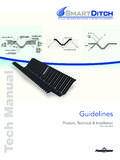Transcription of GUIDELINES - Leachate Control
1 GUIDELINES FOR Leachate Control The term Leachate refers to liquids that migrate from the waste carrying dissolved or suspended contaminants. Leachate results from precipitation entering the landfill and from moisture that exists in the waste when it is disposed. Contaminants in the buried refuse may result from the disposal of industrial waste, ash, waste treatment sludge, household hazardous wastes, or from normal waste decomposition. If uncontrolled, landfill Leachate can be responsible for contaminating ground water and surface water. The composition of Leachate varies greatly from site to site, and can vary within a particular site.
2 Some of the factors affecting composition include: Age of landfill Types of waste Degree of decomposition that has taken place; and Physical modification of the waste ( shredding). Once ground water is contaminated, it is very costly to clean up. Today s landfills, therefore, undergo rigorous siting, design, and construction procedures that provide many safeguards for the Control of Leachate migration. A designed lining system, which ensures low-permeability limit the movement of Leachate into ground water. Liners are made from low-permeability soils (typical clays) or synthetic materials ( plastic). Landfills can be designed with more than one liner, and a mix of liner types may be used.
3 The Minimum Requirements for Waste Disposal by Landfill from the Department of Water Affairs and Forestry (Appendix ) gives detail information on landfill liner designs for the different classes of landfill sites. Leachate collection systems are installed above the liner and usually consist of a piping system sloped to drain to a central collection point where a pump is located. Once the Leachate has been collected and removed from the landfill, it must undergo some type of treatment and disposal. The most common methods of managing Leachate are: Discharge to sewage treatment works. On-site treatment followed by discharge; and Recirculation back into the landfill.
4 Treatment in a sewage works In some cases, landfill Leachate can be added into incoming wastewater stream at a sewage works, where it is biologically, physically, and/or chemically treated. In South Africa the routine treatment of leachates has tended to concentrate on biological treatment in order to reduce the organic components to acceptable levels. Biological treatment can be preceded by treatment of the organic constituents by physical or chemical treatment, in order to make the liquid more acceptable for biological processing, since the best overall treatment efficiencies can generally be achieved by removing the inorganic constituents first, and then removing the organic constituents. The approach protects the subsequent biological and other processes such as adsorption and air stripping from problems caused by metal toxicity, corrosion and scaling.
5 A third stage treatment by using various physical and chemical treatment methods can be used after the biological process to clean up or polish the Leachate in order to remove recalcitrant organics or inorganic materials such as high salt levels that cannot be directly discharged into the environment. Physical treatment processes Physical treatment methods are used to remove, separate and concentrate hazardous elements and compounds, both organic and inorganic, from dilute and concentrated waste streams. Most physical treatment methods that have been applied to Leachate treatment are conventional technologies and can remove a variety of problem contaminants. Increasingly, membrane technologies other than simple reverse osmosis such as Electrodialysis and Ultrafiltration are being applied.
6 However, most membrane technologies suffer from problems associated with blockage of the membranes and landfill leachates with their relatively high COD s are often not good candidates for these technologies. Reverse osmosis, has, however, had some success. Pre-treatment with physical technologies prior to biological treatment have been largely using sedimentation, coagulation and flocculation or filtration in order to remove suspended solids. After biological treatment, the presence of high concentrations of salts normally prevents direct discharge to the environment. Options for treatment include evaporation or reverse osmosis with the recovery of a brine or solid salt material that often has to be disposed back into the landfill.
7 Clearly, unless this process is managed carefully it is essentially self-defeating, since the salt can re-enter the Leachate and the treatment cycle has to be repeated. Chemical treatment methods Chemical treatment methods have been widely used to treat Leachate . This includes neutralisation, oxidation, precipitation and wet-air oxidation. Chemical pre-treatment of Leachate prior to biological treatment has included the addition of an alkali, usually lime, in order to raise the pH and to precipitate out heavy metals or, if the amount of Ca in Leachate is a problem, soda ash is added to precipitate calcium carbonate. Chemical oxidation has also been widely used in South Africa. Hydrogen peroxide is being used at most H sites in South Africa for the mitigation of odours produced by the Leachate , since it readily reacts with any sulphide and mercaptan components that normally cause the odour.
8 Hydrogen peroxide is expensive and large amounts would be required to have any significant impact on the concentration of organics in the Leachate . In the UK, ozone has been used to oxidise recalcitrant organics such as human acids, in order to break the molecules and make them more susceptible to biological treatment. Biological treatment Biological treatment methods are processes whereby microbes are used to destroy or at least reduce the toxicity of a waste stream. Normally biological treatment of predominantly aqueous wastes such as Leachate is accomplished in specially designed bioreactors. A suitable culture of the micro-organisms or microbial association, either aerobic or anaerobic, is chosen. Biological treatment is firmly established as the standard method of waste treatment for some wastes.
9 Domestic sewage Waste from food processing Hazardous waste phenols, cyanide, oils Leachates For leachates, a large number of approaches to biological treatment are proposed, but many are unproven and have not yet been shown to be effective on site. The general types of transformations that can be accomplished biologically include: Degradation of organics to products such as carbon dioxide, methane, water and inorganic salts phenols Reduction of inorganic compounds nitrate Complexation of heavy metals nickel Discharge to a sewage works, however, is not an option in all cases. Care must be taken not to interfere with operations at the sewage works. The contaminants in Leachate can sometimes upset sewage works operations.
10 Typical Leachate can often exceed the required discharge limits particularly in terms of COD and salt content. The discharge of heavy metals into the sewer system is, normally strictly controlled. Those metals of concern to the water authority include Fe, Zn, Cd, As, and Hg. The last three are normally present in extremely low amounts of leachates, particularly from domestic sites, although high amounts of Fe are often found. On-site treatment When discharge to a sewage system is not feasible, constructing treatment facilities on-site with the sole purpose of treating Leachate may be necessary. The Aloes Class H:H disposal facility in the Eastern Cape is an example of this. These facilities will add to the cost of a new facility, but may be required to meet environmental standards.
